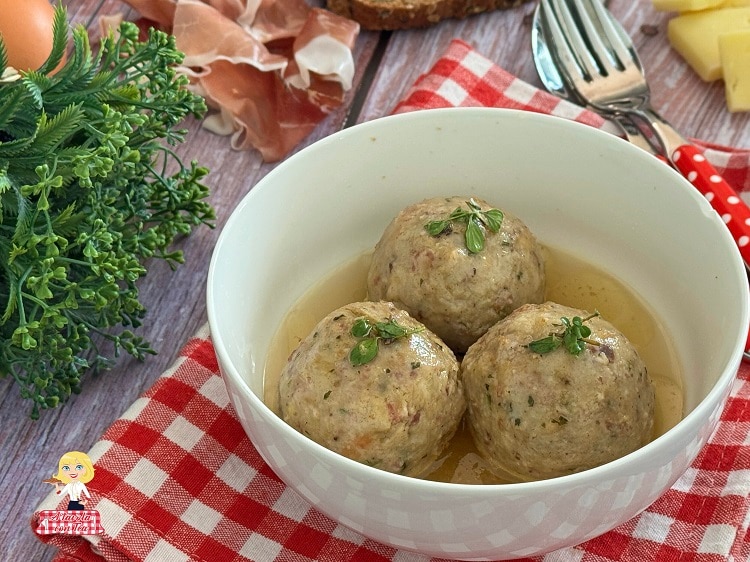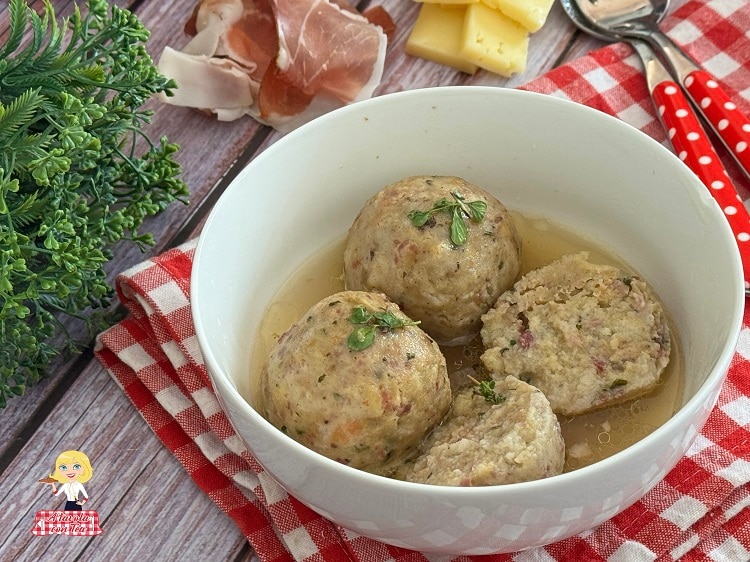SPECK DUMPLINGS (KNODEL)
The SPECK DUMPLINGS or SPECK KNODEL are a traditional recipe from many countries in Northeast Europe, but particularly from South Tyrol and Trentino.
The name is the translation from the German knödel, meaning “lump,” due to their rustic and irregular appearance, as they are a recipe mainly made with leftover bread mixed with milk and eggs and combined with other ingredients found in the pantry, such as speck.
Today we will see together how to make Speck Dumplings and achieve a perfect consistency, neither too firm nor too soft, which falls apart during cooking.
Speck Dumplings are a very simple preparation in which bread is the main ingredient, and for this reason, it must be chosen carefully, meaning you have to select a suitable bread. Rustic loaves or Tuscan bread work well; it’s better to avoid hard dough bread, which would dissolve in milk. Some people also use the crust, while others prefer to remove part of it; it’s a matter of personal taste: if you leave it, just check that it has softened well and blends with the rest of the dough.
But the real secret to making Speck Dumplings perfectly is their consistency: they must be compact yet soft … the mistake is lurking around the corner, making them too soft so that they fall apart during cooking or too hard that they remain raw is possible.
Certainly, one mistake not to make is having a dough that sticks to your hands (in that case, it’s better to add a little flour), another tip is to crumble the bread well because large pieces prevent the binders from doing their job and create a “hole” in your dumplings’ dough.
Now all that’s left is to prepare together the original South Tyrolean recipe of SPECK DUMPLINGS to be savored in broth, as tradition dictates, but also dry with melted butter and aromatic herbs.

- Difficulty: Very Easy
- Cost: Economical
- Preparation time: 40 Minutes
- Portions: 5
- Cooking methods: Stovetop
- Cuisine: Italian
- Energy 204.50 (Kcal)
- Carbohydrates 22.52 (g) of which sugars 2.55 (g)
- Proteins 12.08 (g)
- Fat 7.72 (g) of which saturated 3.38 (g)of which unsaturated 3.82 (g)
- Fibers 1.49 (g)
- Sodium 448.39 (mg)
Indicative values for a portion of 80 g processed in an automated way starting from the nutritional information available on the CREA* and FoodData Central** databases. It is not food and / or nutritional advice.
* CREATES Food and Nutrition Research Center: https://www.crea.gov.it/alimenti-e-nutrizione https://www.alimentinutrizione.it ** U.S. Department of Agriculture, Agricultural Research Service. FoodData Central, 2019. https://fdc.nal.usda.gov
Ingredients
- 9 oz stale bread
- 1 cup whole milk
- 1 white onion (about 2 oz)
- 5 oz speck
- 2 eggs (medium)
- 2 tsp butter
- 1 tsp chives
- 1 tsp chopped parsley
- black pepper (a pinch ground)
Tools
- Bowl
- Pan
- Pot
Steps
Before you begin preparing Speck Dumplings, make a good meat broth and keep it warm.
First, cut the speck into very small pieces, about 1/12 inch, and set aside. Clean the onion and chop it finely, melt the butter in a pan over low heat, add the onion, and sauté for 1 minute, then also add the speck and sauté for 5 minutes, stirring often. Turn off the heat and set aside.
Cut the stale bread into cubes of about 1/4 inch and chop both the chives and parsley. In a large bowl, place the cut bread, add the milk (start with 7 oz, adding more if needed based on consistency), eggs, chopped parsley, and chives, and mix.
At this point, add the cooled sautéed speck and onion and mix to combine. If the dough is too sticky and soft, add a tiny bit of flour; if it’s too dry, add a splash of milk. Once the right consistency is achieved, we prepare the dumplings.
First, I suggest slightly wetting your hands with water. Then take a bit of the mixture and roll it between your hands to form dumplings one by one, usually about 2 inches in diameter. As you prepare them, place them on a plate or tray. This recipe should yield about 10 Speck Dumplings.
Heat the meat broth prepared earlier and immerse them when it reaches a boil. From this moment, about 15 minutes of cooking will suffice. You can choose to serve them in a bowl with a bit of their cooking broth or “dry” dressed with melted butter and sage. Remember that to enjoy them at their best, they should be served hot.

STORAGE
The raw DUMPLINGS can be stored, sealed in an airtight container, in the fridge for up to 2 days. They can also be frozen raw. If cooked, they should be eaten the same day.
NOTES AND TIPS
BREAD: According to the original recipe, dumplings should be made with typical Tyrolean bread called rosette (kaisersemmel) with plenty of crumb. Alternatively, you can use rustic loaves or Tuscan bread, better to avoid hard dough bread that would dissolve in milk. Some use the crust, while others prefer removing part of it; it’s a matter of personal taste. If you decide to leave the crust, ensure it has softened well and blends with the rest of the dough. If you don’t have stale bread but only fresh, to get the right consistency, just leave it out of the bread bag for a day to dry.
FLOUR: The ORIGINAL South Tyrolean deposited recipe for dumplings includes adding a bit of flour to the dough, with the amount varying based on consistency.
SPECK: You can replace speck with pancetta or the “Lucanica” used in the province of Trento.
VARIANTS: Traditional speck dumplings are served with broth, but nothing prevents serving them in other ways: the simplest is with melted butter and a few sage leaves. Often, dumplings are also served with tomato sauce. Other variations include serving them over a cheese fondue or accompanied by wild boar ragù or white mushroom sauce.
HISTORY AND CURIOSITIES
It is said that dumplings (knödel in the original language, meaning “lump”) originated as a dish for recycling in the poor farming tradition in Bavaria in 1180. Then they spread throughout Northern Europe and arrived in Italy, particularly in the South Tyrol region.

